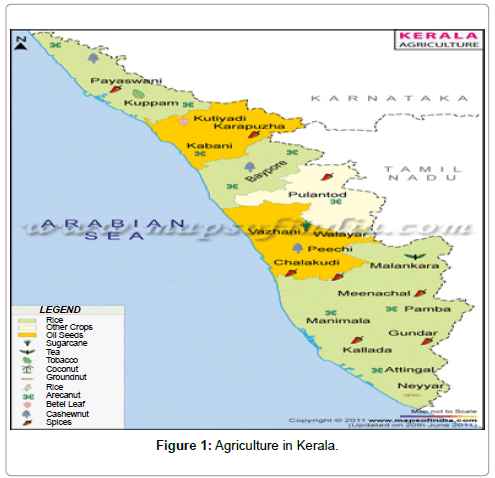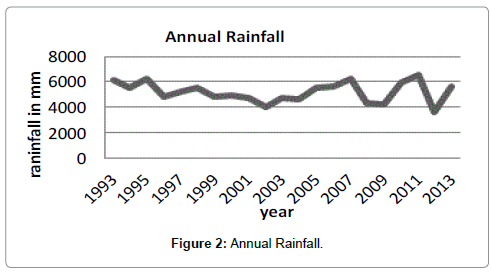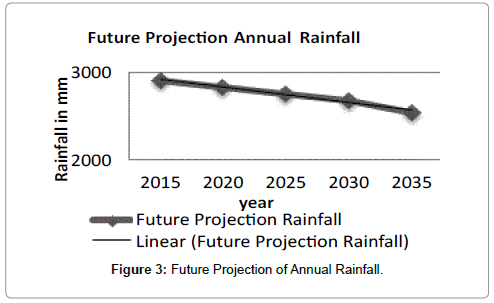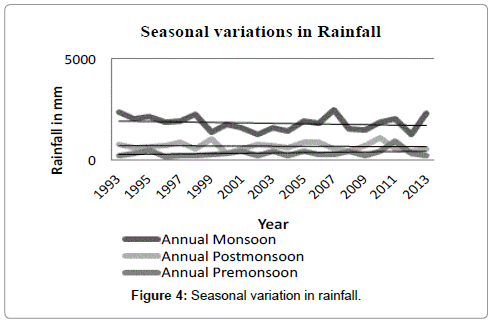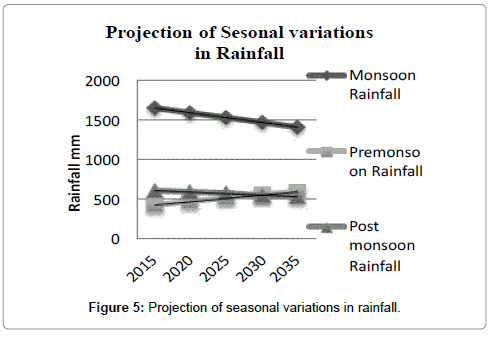A Study on the Scope and Importance of Tuber Crops with Special Reference to Cassava as Resilient Crop towards Climate Change
Received: 04-Mar-2014 / Accepted Date: 06-May-2014 / Published Date: 09-May-2014 DOI: 10.4172/2157-7617.1000202
Abstract
Climate has been recognized as a principal factor that control crop distribution and growth. Agricultural productivity has been found to be exaggerated by climate change, this will results food insecurity and poverty. To find out an alternative food source is very much necessary for the existence of life in such climate change related catastrophic events. This study examines selected meteorological conditions of Kottayam district, especially inter-annual and inter-seasonal trends from a climate change perspective and also reviewed the famer’s perception, tubers as a better resilient crop under extreme weather events on regional basis and their promotion need to be emphasized in a better manner. Simple random sampling procedure was used to select 130 tubers cultivating farmers especially cassava, using extensive field visit and structural questionnaire the data were collected. The collected data were analyzed using descriptive statistics such as frequency table, percentage, mean and chi-square test. The results of the study revealed that climate change was happened on regional basis. The result also highlights the sensitive nature of our staple food crop towards the climate change and hence causes food insecurity related problems. A shift in cultivation trends were also noticed i.e. most of the farmers engaged in rice production now opt tuber, vegetable and other cash crops for cultivation on an extensive basis. Emergences of more tuber cultivation incidence were reported. Cassava and other tubers showed more resilience under climate change events and was found to be sustainable on production and economy basis. The study concluded that the viable and cheap alternatives are the ever resilient tubers.
Keywords: Climate change; Agriculture; Tuber crops; Cassava
7988Introduction
Climate change and climate variability have become a reality today, with a significant threats to ecosystem, food security, water resource and economic stability which are the foundation of life. Numerous studies have been carried out on the impacts of climate variability on crops yield in different parts of the world by Intergovernmental Panel on Climate Change [1] and other scholars. Some of these studies reveal that climate variability has significant impacts on agricultural sector especially during the last 40 year period. According to Intergovernmental Panel on Climate Change [1], climate change refers to any change in climate over time, whether due to natural variability or as a result of human activity [2]; to the article 1 of United Nations Framework Convention on Climate which is attributed directly or indirectly to human activity that alters the composition of the global atmosphere and which is in addition to natural variability observed over comparable time periods [3]. The physics and chemistry of the Earth’s atmosphere largely determines our climate [4]. The continued upsurge of greenhouse gases warm up the earth’s surface and lead to increase in air temperature; ultimately results change the pattern of precipitation. The observed changes and future projections shows that the Green House Gases (GHG) such as atmospheric carbon dioxide (CO2) present concentration 360 ppm doubling up to 700 ppm by the 21st century and other gases like Methane(CH4) from 700 to 1720 ppm, Nitrous Oxide (N2O) from 275 to 310 ppm and Chlorofluorocarbon (CFCs) respectively [1,5]. Due to summer monsoonal circulation, the weather and climate are subjugated by largest seasonal mode of precipitation around the world. This seasonal mode, the precipitation variability has predominant inter-annual and intra-seasonal, giving rise to extreme seasonal anomalies resulting large scale drought, floods, heavy rain, hailstorms, heat stress and high wind extremes. It is predicted that the mean global surface temperature increases by 3°C to 5°C from present levels and South and East Asia of rice producing zones air temperature predicted to increase up to 7°C . Extreme weather events are expected to increase in future. India is developing country, is first and foremost an agricultural nation providing livelihood to more than 65-70% of the population. Heat stress is one of the most vital factors affecting crop yield [6]. Reports show that Asia-Pacific regions are likely to face the nastiest impacts on cereals crops. The cereals yield loss estimated that incase of wheat, rice, maize in vicinity of 50%, 17%, and 6% respectively by 2050. For every 10°C increase in temperature adversely affects yield of wheat, soybean, mustard, groundnut, potato are expected to decline by 3-7% whereas in case of rice yield may decline by 6% for every 10°C increase in temperature. Indian Network for Climate Change Assessment [7], in their 1st report pointed out that reduced rainfall; increased atmospheric temperature and flooding due to sea level is climate change scenario for the Western Ghats and Kerala in next 20 years. Kerala is an agricultural state, is the third highest population density in India. Acute food insecurity, import grain, heavy unemployment is the problems faced by the state. It is estimated that minimum air surface temperature in Western Ghats regions may rise by 2 to 4.50°C. The average temperature in the regions bordering Kerala is likely to rise by 1 to 30°C. There is clear evidence shows that climate change occurred in Kerala. Apart from the present problems frequent occurrence of weather abnormalities is part of climate change will adversely damaging agriculture sector results food price increase. The state experience unusual summer rain and other climate anomalies like drought, floods, high wind like hazards all are upshot of climate change. The scientist says that the present weather related hazards will continue in future. The staple food of Keralites is rice which is highly vulnerable to climate change. Several studies evident that the rice is under threat of climate change also leads to the reduction in yield. Here the present study is an endeavor to track the scope of promoting the cultivation of tuber crops as an additional substitute for staple food, increase of climate change associated emergency cases such as extreme weather events and related disasters especially among marginalized people on a regional basis. One plus point of tropical root and tuber crop is that the economically important part that is tuber and shoots grows simultaneously during normal or unfavorable conditions. These crops cease tuber development as well as vegetative growth and become dormant during unfavorable conditions such as drought, flood, and heat stress condition. Tuber growth resumed during favorable conditions. So there is less chance of crop failure. But in the case of cereals the flowering and grain filling stages are critical period of growth are highly sensitive to environmental stress condition, although vegetative growth is tolerant to these stress conditions. Therefore if cereals face these stress condition during their critical growth period, then the entire crop will lost. Cassava is considered as the future food security crop as regards to its biological efficiency coupled with ability to sustain under changing climate especially during drought (by shedding leaves) and to grow well in marginal soils. Sweet potato can tolerate and yield considerably under saline conditions whereas elephant foot yam, tannia and arrow root are tolerant to shade conditions. Cassava was found to maintain nearly 50% of its photosynthetic rate under drought condition [5] offering a better alternative of crop in future warming climate conditions. Cassava act as global warming mitigating crop and cassava is also a source of starch and therefore industrially important crop and also used in animal husbandry. Cassava shows significant growth under high temperature and CO2 [5]. The tuber crops needs less maintenance and high yield, it forms the important component of food and nutritional security of especially poor and marginal farmers. The specific objectives of the study are the following:
• Assessment of selected meteorological conditions of the study area especially inter-annual and intra seasonal trends from a climate change perspective.
• To assess the trends in cultivation patterns of tuber crops in the study area.
• To find out the impacts of common natural hazards such as floods, drought, high precipitation, winds on tuber crops.
• To understand and evaluate farmers perception on the resilience of tuber crops under these hazards and adaptation strategies to cope with the impacts.
Study Area
The selected study area for the research was Kottayam district in the Indian state of Kerala. The district is boarded by lofty and mighty Western Ghats on east and Vemband lakes and paddy field of Kuttanad on the west. The district has Meenachil River and a network of canals running across with considerable number of settlements and agricultural lands set up on the bank of the river. The climate of Kottayam is basically shrewd blend of tropical and equatorial climate. Weather of the locality characterized as hot and humid. Summer season in Kottayam start from March and last till June, where temperatures are extremely high during March to May. The district also receives plenty amount of rainfall during Monsoon season from July to September and north east monsoon brings winter rain during October to November together add an annual rainfall of 2701 millimeter to the region. The Kottayam district is a multi-hazard prone area where flood, lightening, landslides, drought etc. are the natural disaster faced by the vicinity. The important food crop cultivated in the district was rice, staple food for the people, whereas the other major food crops widely cultivated area rubber, cassava, coconut, banana, tuber crops, pepper, and vegetables (Figure 1).
Materials And Methods
This work consists of a list of farmers growing root crops especially cassava collected from selected villages of 5 taluks of Kottayam district, and 130 farmers were collected at random. Extensive field visiting using personal interview schedule, the data relating landholding status of tuber crops, status of fertilizers application and irrigation, cost of production, production and productivity of tuber crop, major constraints in production of tuber crops, farmers perceptions towards the resilience of tuber crops and crop insurance status were collected during April 20th 2013. Secondary data includes meteorological data collected from Rubber Board, Kerala for the period from 1993-2013 were utilized for the study. Other secondary data were collected from the government revenue department offices, Agriculture department Kottayam, reports, articles published in journals and in newspapers. The collected data were analyzed using suitable statistical techniques. Descriptive statistics such as frequency table, mean, and percentage analysis, Test of significance-Chi-square test were major statistical tools used in this study.
Result And Discussion
Result of meteorological data analysis
The collected data from the time period of 1993-2013 were categorized and analyzed for further conclusion. The Figure 2 shows that from the two decades rainfall shows a deceasing trend in the study area. The maximum rainfall received in the year 1995 (6293.7 mm) and the minimum rainfall received in the year 2012 (3260.2 mm). If the current trends continues rainfall may further decreases with each year and the decrease in the amount of can be projected with the help of depended variables of the equation given in the time series, the projected values obtained shown in the Figure 3 also shows the decreasing trend of annual rainfall. Along with the changes in the amount of rainfall availability, Climate change has also brought changes in the total number of rainy days. The future projection also shows a slight increase in rainy days (Figure 4 and 5). The study found that seasonal variations in rainfall, monsoon rainfall shows a sharp declining trend whereas pre-monsoon and post monsoon rainfall shows a slight increasing trend. Considering the agriculture pattern of the study area, it is solely depend upon the extent and magnitude of monsoon. Hence it is matters of concern regarding agriculture productivity, especially that of rice from a climate change perspective. Two decadal data of maximum and minimum temperature in the study area shows slight increase and decreasing trend. If the current trends continues maximum temperature increases with each year whereas minimum temperature decreases.
Result of rice cultivation and production status
Rice is the most important cereal and staple food produced and consumed by the Keralites. In Kottayam district also rice is cultivating in a vast areas. Other than rice cassava, coconut, pepper, rubber, banana and other vegetables are cultivated. The study also encloses a part of Kuttanad rice bowl and other rice cultivating tracts in Kottayam district. The government records shows that, in Kottayam district during 1993- 94 nearly 29723 hectares of land were under paddy cultivation with a production rate of 61002 tones while during 2012-13 it was only 17511 hectare with production rate of 29589 tones. The situation prevailing and the farmers reported that in the paddy production of the study area shows that both the area of paddy cultivation and paddy production declining considerably on annual basis. The trend of rice cultivating area and production in Kottayam district covers the study area.
The farmers also reported that a variation in climate plays an important role in the growth and development of paddy. The low profitability in paddy cultivation appears to have contributed to the shifting of paddy land to other crops and other construction activities. Most of the farmers are preferred tuber crops especially cassava and elephant foot yam, colocasia and other cash crops like rubber, pepper, coconut. A clear cut reduction in the production of rice in the locations like Vaikom (46%), Kaduthuruthy (38%), Kuruvalangad (45%) and Marungattupally (56%) were reported. It evidently shows that climate variability mainly alteration in temperature and rainfall are the two major contributing factors of rice reduction in production. Major climate related reasons cited from farmers in the reduction in production of paddy in the study areas are, regular flood submergence during monsoon and saline water intrusion during summer, heavy rainfall and flash floods and resultant bund breaching which affects the second round of rice cultivation, prevalence of dampness and high moisture during harvesting time, unexpected wind which will fall of ready to harvest rice, dry spell along with high temperature stress condition all together contributing the paddy cultivation under menace.
Result of socio economic characteristics
The result of socio-economic analysis represented on Table 1 shows the age, sex, marital status, farming experience, household size, farm size and aim of production. The results shows that greater part (40.7%) of the tuber cultivating farmers especially cassava, was of 43 years with oldest being 74 years and youngest being 27 years. This could probably imply that the farmers who are actively participated for the study were old enough to have been able to experience the changes in climate and as such able to give liable response to the questions in the research. It also shows that 90.7% of the farmers were male while the rest percentage (9.2%) was female; it means that males are involved in tuber farming their female counterpart. A large percentage of (84.6%) tuber cultivating farmers were married, this may help to reduce the hired labour if the farmers family engage the farming activities. Most (50.7%) of the respondents have family size ranges between 6 and below.
| Characteristic | Variables | Frequency | Percentage | Mean |
|---|---|---|---|---|
| Age | 21-30 | 11 | 8.40% | 43.6 |
| 31-40 | 42 | 32.3 | ||
| 41-50 | 53 | 40.7 | ||
| 51-60 | 12 | 9.2 | ||
| 61-70 | 9 | 6.9 | ||
| 71-80 | 3 | 2.3 | ||
| Gender | Male | 118 | 90.7 | |
| Female | 12 | 9.2 | ||
| Marital Status | Single | 16 | 12.3 | |
| Married | 110 | 34.6 | ||
| Divorced | 1 | 0.7 | ||
| Widowed | 3 | 2.3 | ||
| Farming Experience | 10 & below | 11 | 8.4 | 25.4 |
| Nov-20 | 43 | 33 | ||
| 21-30 | 32 | 24.6 | ||
| 31-40 | 27 | 20.7 | ||
| 41-50 | 14 | 10.7 | ||
| Above 51 | 3 | 2.3 | ||
| House Hold Size | 5 & below | 61 | 46.9 | 6 Persons |
| 06-Oct | 66 | 50.7 | ||
| Nov-15 | 3 | 2.3 | ||
| 16 & above | 0 | 0 | ||
| Farm Size | 0.02 hect. & below | 33 | 25.3 | |
| Above 0.02 hect.-below 0.4 hect. | 39 | 30 | ||
| Above 0.4 hect.-below 1 hect. | ||||
| 1 hect .&above | 41 | 31.5 | ||
| 18 | 13.8 |
Source: Field survey 2013
Table 1: Distribution by socio-economic characteristics.
The table also shows that the result of the farming experience of the farmers that 33% of the farmers had more than 10 year experience. It further shows that 36.1% of the respondent had access to land below 0.4 hectare- below 1 hectare while 13.8% had between 1 hectare of lands and above.
It was also shows that approximately 27.6% of farmers producing the tuber crop had sale of product as their major aim of production. 20.7% had consumption as their major aim production while 51.5% had both sale and consumption as their major aim of production.
Result of production and productivity of cassava
Table 2 indicates the features of cost of production and productivity of tuber crops especially tapioca in Kottayam district. It shows that 83% of the farmers are depending rainwater as the major source of tuber growth whereas only 16.9% farmers depends other irrigation mediums like well, other water sources. 68.4% farmers are adopted organic farming, much eco-friendly and devoid of any health issues while handling, although 31.5% farmers using chemical fertilizers mainly urea, potash, rock dust (mineral fertilizer). The table also shows that 40.7% of the farmers produce less than 1000 kg/ha of cassava, 22.3% of farmers produce between 1000-2000 kg/ha while 17.6% of farmers produce greater than 4000 kg/ha of cassava tuber. The result also reveals that 33% of the farmers earned greater than 75000 Indian rupees per period which means that ¼ of the cassava producers in the study area gained high profit. To analyzed the crops insurance status only 16.1% farmers are insured their tuber especially cassava whereas 91.5% of farmers were not insured their crop because of the resilience of the crops towards weather related catastrophes. Same time it is noticed that the crops like rice, rubber, banana and other crops are insured by the farmers because of the vulnerable nature of these crops.
| Characteristics | Frequency | Percentage |
|---|---|---|
| Farm accessibility | ||
| Near | 65 | 50 |
| Far | 65 | 50 |
| Source of water | ||
| Irrigation | 22 | 16.9 |
| Rain water | 108 | 83 |
| Fertilizer application | ||
| Organic farming | 89 | 68.4 |
| Inorganic farming | 41 | 31.5 |
| Plant protection | ||
| Fencing | 11 | 8.4 |
| No protection | 119 | 91.5 |
| Quantity of cassava | ||
| 5340.7 | ||
| 1000-2000 | 29 | 22.3 |
| 2000-3000 | 14 | 10.7 |
| 3000-4000 | 11 | 8.4 |
| >4000 | 23 | 17.6 |
| Earnings | ||
| 10,000 & below | 15 | 11.5 |
| 10,000-25,000 | 27 | 20.7 |
| 25,000-50,000 | 26 | 20 |
| 50,000-75,000 | 19 | 14.6 |
| 75,000 & above | 43 | 33 |
| Crop insurance | ||
| Yes | 21 | 16.1 |
| No | 119 | 91.5 |
Source: Field survey 2013
Table 2: Distribution by production and productivity of Cassava.
Result of cropping pattern
Crop rotation and intercropping are the two extensively practicing methods used by the farmers in the study area were reported. Majority of the farmers (80%) reported that intercropping tuber crops such as green gram, black gram, vegetables like brinjal, chilly, amaranthus and fruit crop like banana. This can be highly profitable and are being successfully adapted by the farmers in the study area. 20% of the farmers are growing cassava alone and crop rotation pattern was implemented in their field. The farmers reported that the crop rotation and intercropping methods will improve the soil productivity and lushness. Growing cassava and yam under coconut plantation, cassava based agro-forestry systems such as cassava and mango/guava are other cropping systems followed by the farmers in the study area, Kottayam. The farmer’s highlights that by practicing these methods they have increase profit and the same time they can produce more than three crops and protect soil naturally.
Result of farmer’s perception
The meteorological data clearly showed the climate change happening regional level and it related natural anomalies are occurring in the study area. The common natural hazards occurring in Kottayam district are flooding, drought, landslides, cyclones. These hazards produced notable changes in rice production. But the farmers engaged in tuber production especially cassava reported that cassava are highly heat tolerant and tide over the unfavorable condition by shedding their leaves and reducing transpiration rate. The plant also showed that the plant grow in the normal land and also under paddy polders, water logging condition. The Table 3 shows of the total respondent (130) nearly 68% recorded that event of temperature hike does not affect the tapioca plants where under polder situation 58% recorded the resilience. In case of other tubers 66% of the respondents marked the category as temperature resilient or tolerant. The anomalies in rainfall (erratic rainfall) events reported to produce minimal damages to both tapioca and other tuber in the study area. The extreme rainfall events hence found to produce minimal disturbance to this crop category. Nearly 60% of respondent recorded the resilience of cassava towards increased rainfall whereas 63% towards decreased rainfall. The change of occurrence of weather or climate induced diseases and pest outbreaks where comparatively lower in the study area since tubers are found to be resistant to such incidence. Owing to its potential to tide over stress conditions cassava found to be cultivated in arable land and in field conditions along with paddy i.e., on bunds and reclaimed paddy polders. The respondent reported their satisfaction in cultivating tuber especially cassava under climate change scenario s owing to its innate capacity to cope with events related to changing weather and climate.
| Tapioca (on land) | Tapioca (under paddy polder) | Other tubers (yam, elephant foot yam, sweet potato, clolcasia, lesser yam) | |||||||
|---|---|---|---|---|---|---|---|---|---|
| Not affected (%) | Slightly affected (%) | Highly affected (%) | Not affected (%) | Slightly affected (%) | Highly affected (%) | Slightly affected (%) | Not Affected (%) | Highly affected (%) | |
| Increase Temperature | 68 | 35 | 6 | 58 | 20 | 20 | 66 | 20 | 6 |
| Decrease Temperature | 73 | 32 | 2 | 63 | 17 | 18 | 61 | 23 | 14 |
| Increase Rainfall | 60 | 33 | 8 | 54 | 27 | 17 | 69 | 19 | 11 |
| Decrease Rainfall | 63 | 28 | 10 | 60 | 23 | 15 | 73 | 16 | 10 |
| Climate change related disease | 62 | 28 | 12 | 55 | 35 | 9 | 66 | 17 | 15 |
| Uncertainty of weathers | 58 | 27 | 18 | 53 | 29 | 17 | 63 | 22 | 6 |
Source: Field survey 2013
In order to verify the farmers perception towards resilience of tuber crop especially cassava whether statistically Chi-Square test has been applied. The results are presented in the Table 5
Ho: The research is unbiased, the climate change related catastrophes affects tuber crops especially cassava production (null hypothesis)
H1: The research is biased, the climate change related catastrophes not affects tuber crops especially cassava production (Alternative hypothesis)
Table 3: Distribution by farmer’s perception regarding the resilience of tuber crops towards climate change.
Since the calculated value of χ2 (1.8) is much below the table value (3.145) which infers it is not statistically significant. Hence the null hypothesis is accepted and it can be concluded that the research is unbiased i.e., climate change related catastrophes will not affects the tuber crops especially cassava production (Table 4 and 5).
| Affect Cassava growth | Not affects cassava growth | ||
|---|---|---|---|
| Climate change | Yes | 45 | 85 |
| No | 35 | 95 |
Table 4: Distribution by Farmers perception resilience of tuber crops especially cassava towards Climate change related catastrophes.
| Category | N | Test of significance | Calculated Value | Table Value | Level of significance | Comment |
|---|---|---|---|---|---|---|
| 2 | 130 | X2 | 1.8 | 3.145 | 5% | NS |
Table 5: The summery of Chi-Square result of farmer’s perception.
Conclusion And Recommendation
The study was basically focused on the effects of climate change on tuber crops especially cassava and how it was resilient towards the impact of climate change related catastrophes in Kottayam district of Kerala state, India. The study showed climate change happening on regional basis. The annual rainfall and seasonal changes and temperature shows changing trends and these changes produce notable variation on crop production especially rice, the staple food sensitive nature towards variations in climate and hence causes food insecurity issues which is largely affected by the marginalized community. Tubers especially cassava is likely to outperform other crops amid rising temperature and could even become more productive, offering farmers a way to cope with change climate change. The study also shows a shift in cultivation trends i.e. most of the farmers engaged in rice production now opt tuber crops, vegetables and cash crops like rubber and pepper. The farmer’s perception towards the resilience of tuber crops especially cassava under climate change related catastrophes showed most of the farmers are satisfied with production and consumption as better income generating and profitable ever sustaining field other than rice. The farmers reported that cassava are drought tolerant, rich in carbohydrate content and sustain communities throughout the year as the main source of calories. The chi square test also shows, test is not statistically significant i.e., climate change related catastrophes will not affects cassava production. Therefore it is noted that the climate change relates issues is not affected in the tuber production of the study area. The study concluded that the area under rice, the foremost cereal crop in Kottayam district is fast receding and the number of mouth to feed rapidly increasing day by day. The price peak of staple food and its vulnerability towards the climate related catastrophes such as flood, drought make situation more complicated, generally affecting marginalized poor people. In such circumstances the viable and cheap alternatives are the ever resilient tuber crops especially tapioca.
References
- Intergovernmental Panel on Climate Change-IPCC (2007) Climate change impacts, Adaptation and Vulnerability. Cambridge University Cambridge, UK.
- Intergovernmental Panel on Climate Change-IPCC (2001) Climate change 2001: Synthesis report. Cambridge University Press. Cambridge, UK.
- UNFCC (1992) United Nations Framework Convention on Climate Change Secretariat, Bonn, Germany.
- Lockwood JG (1999) Is potential evapotranspiration and its relationship with actual evapotranspiration sensitive to elevated atmospheric CO2 levels. Clim Change 41: 193-212.
- Ravi V, Saravan R (2001) Photosynthesis and productivity of cassava under water deficit stress and stress free conditions. J Root Crops 27: 214-218.
- Wrigley CW, Blumental, Gras C, Barlow PW (1994) Temperature variation during grain filling and changes in wheat grain quality. Aus J Plant Physiol 21: 875-885.
- Indian Network for Climate Change Assessment-INCCA (2011) Climate Change and India: A 4X4 Assessment - A sectorial and regional analysis for 2030. Ministry of Environment and Forests, Government of India.
Citation: Anju L, Ambily PG, Gopikrishna VG, Amalraj M (2014) A Study on the Scope and Importance of Tuber Crops with Special Reference to Cassava as Resilient Crop towards Climate Change. J Earth Sci Clim Change 5: 202. DOI: 10.4172/2157-7617.1000202
Copyright: © 2014 Anju L, et al. This is an open-access article distributed under the terms of the Creative Commons Attribution License, which permits unrestricted use, distribution, and reproduction in any medium, provided the original author and source are credited.
Select your language of interest to view the total content in your interested language
Share This Article
Recommended Journals
Open Access Journals
Article Tools
Article Usage
- Total views: 19944
- [From(publication date): 8-2014 - Aug 25, 2025]
- Breakdown by view type
- HTML page views: 15150
- PDF downloads: 4794

